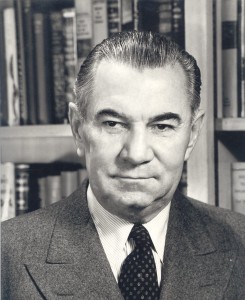
A combination of Larry Bell’s love and enthusiasm for flying, along with his ability to convince others that his ideas would work, made Bell Aircraft Corporation a respected name in aviation.
By Stuart Leuthner
High in the main gallery of the National Air and Space Museum in Washington, D.C., near the Spirit of St. Louis and the Wright Flyer, hangs the Bell X-1. The stubby-winged, orange and white, bullet-shaped machine—with Colonel Chuck Yeager as pilot—was the first airplane to shatter the sound barrier.
Tom Wolfe’s book, “The Right Stuff,” and the movie based on it, helped make the X-1 one of the world’s most famous airplanes. The opposite is true of the man who built the X-1. This is unfortunate, because Lawrence Bell, relatively unknown outside aviation, was one of that industry’s most accomplished salesmen.
Bell didn’t build the vast numbers of aircraft men like Douglas, Boeing and Piper did, but his company established a record of innovation that few can match. Along with the X-1, these included the first modern use of a tricycle landing gear on an operational fighter and use of remote fire control and ranging mechanisms in an aircraft, as well as the first American jet aircraft, FAA approved helicopter, jet-powered vertical takeoff and landing aircraft and plane to reach Mach 3. It also included the only successful fighter with its engine mounted behind the pilot. A combination of Bell’s love and enthusiasm for flying, along with his ability to convince others that his ideas would work, made Bell Aircraft Corporation a respected name in aviation. The X-1 is not Bell’s only contribution in the National Air and Space Museum. Other Bell products on display include the XP-59, the first American jet, the original Rocket Belt and the Agena engine.
When U.S. Air Force officials wanted a pilot to try flying the X-1 past the speed of sound (Mach 1), they found the search somewhat difficult. More than one expert suggested that an airplane hitting the sound barrier would simply disintegrate. Geoffrey de Havilland seemed to prove the engineers right; while piloting one of his father’s DH-108s in an attempt to fly through Mach 1, the airplane disintegrated. The Washington Evening Star stated, “Beyond (the speed of sound) lies a no man’s land of turbulent, aerodynamic forces, uncharted even in the most advanced wind tunnels.”
Chalmers “Slick” Goodlin, a Bell test pilot, flew the X-1 on several of the plane’s early flights.
“Goodlin was offered a fat reward (a rumored $150,000) for flying it at full speed, but he didn’t like the terms,” TIME Magazine reported in its April 18, 1948 issue. “Another civilian pilot had a try at the X-1 and hastily bowed out. Then the Air Force took charge and gave the job to Chuck Yeager, who did it in the line of duty for a captain’s salary ($511.50 a month, including flying pay and extras).”
Yeager, who had a reputation as a fearless fighter pilot during World War II, became a test pilot when the war ended. In his autobiography, Yeager remembered Bell, along with a group of Air Force brass and other personnel, taking him to see the X-1.
“Larry Bell was a great salesman,” he wrote. “He was a self-made man, in love with aviation all his life. By the time he got through selling us on the beauty of his orange beast, we were ready to believe the X-1 could punch its way through the Pearly Gates and make it back covered with angel’s feathers.”
Glenn Martin
The youngest of 10 children, Lawrence Dale Bell was born on April 5, 1894. His father, Isaac, owned a lumber mill in the small town of Mentone, Ind. His mother, Harriet, was a school teacher. When Bell was 13, his father sold the business and moved the family to California.

The Airacuda was the first military aircraft produced by the Bell Aircraft Corporation. Construction began in May 1936, and the XFM-1 first flew on Sept. 1, 1937. A bold design, the aircraft was plagued with problems and only 13 were produced.
Larry Bell saw his first plane at an air show. Held in 1910, at Dominquez Field near Long Beach, Calif., it attracted some of aviation’s early legends, including Glenn Curtiss and Lincoln Beachey. Bell attended the show with his brothers Vaughn and Grover; they went home to Santa Monica with a fascination for airplanes. When Grover Bell called Glenn L. Martin, the pioneer airplane builder in nearby Santa Ana, and asked him for a job, Martin brought him aboard and taught him how to fly. In 1912, Grover joined Beachey on the exhibition circuit.
Larry Bell dropped out of high school that same year and went to work for his brother and Beachey, as a mechanic. He was devastated after his brother, fast becoming one of America’s best-known aviators, was killed practicing for a show. They had often discussed opening an aircraft company of their own. Although he once determined he would have nothing more to do with airplanes, it was not long before Bell went to work for Martin as a stockroom clerk, later becoming shop foreman.
In 1913, Bell convinced Martin to put on an exhibition that he called “The Battle of the Clouds.” The show included a parachute jump, balloons and exhibition flying, but the main attraction was the aerial bombing of a make-believe battlefield—complete with a fort, cannon and soldiers. Bell wanted to give the crowd its money’s worth, and he certainly did that. Martin flew over the painted cloth and wood fort, throwing out oranges, while Bell set off dynamite charges on the ground. Martin Company employees, armed with rifles, fired off blank cartridges. The cannon, also made of cloth and wood, caught fire, and as Bell set off his last charges and ran for cover, the entire battlefield went up in flames.
Two interested spectators sought out Bell and Martin as they counted the day’s receipts. Pedro and Juan Alcaldez were representatives of Pancho Villa, who at that time was living in exile in the United States, planning his return to liberate Mexico. The Alcaldez brothers wanted to know what it would cost for a real bomber. Martin offered to build an airplane for them, at the cost of $10,000—bombs extra. The two brothers paid cash, and the Martin factory went to work on “Pancho Villa’s Air Force.”
Employees modified a two-seat biplane, so the mechanic could toss bombs from the front seat. Bell even built the bombs—lengths of pipe filled with dynamite and fitted with detonator caps. Later that summer, the world’s first combat bomber went into action. American pilot Didier Masson and British mechanic Tommy Dean tried—unsuccessfully—to bomb Mexican federal gunboats in Guaymas Bay.
In 1914, Bell became the Martin Company’s shop superintendent. In addition, he was head salesman, purchasing agent, labor relations representative and contracts writer. A year later, he married Lucille Mainwaring, a Martin secretary.
Rising to vice president and general manager in 1920, Bell never missed an opportunity to promote aviation. Prior to an upcoming event, the Cleveland Industrial Alliance described Bell as a speaker with “a rare gift of presenting cold facts in the most fascinating grab” and with the ability to deliver technical information “with the brightest humor.”
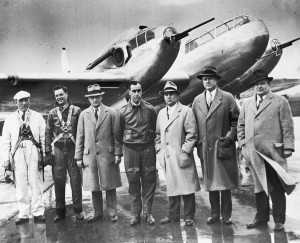
Larry Bell (third from right) poses with the FM-1 crew and Bell executives at Buffalo Airport in the late 1930s. Although the bomber-killer never saw combat, it proved that Bell Aircraft could build excellent planes.
While he was promoting aviation, Bell became less enchanted with Glenn Martin. He felt that his contributions had earned him part ownership.
“I may quit Martin,” he told Lucille. “I’m number two man, and always will be.”
In late 1924, he confronted Martin and presented him with an ultimatum. Martin wouldn’t budge, and Bell left the company at the beginning of 1925.
Consolidated and Fleet Aircraft
The aviation industry was in the doldrums, and it would be three years before Bell could find another job building airplanes. During that time he sold a variety of products and became involved with a bizarre scheme to find a lost gold mine in Arizona.
The economy eventually improved, and Bell went to work for Consolidated Aircraft in Buffalo, N.Y. In his agreement with the company’s owner, Major Rueben H. Fleet, Bell was guaranteed an interest in the company. A retired army officer, Fleet was a well known flier, who had helped organize the first U.S. airmail service in 1918.
Not long after Bell joined Consolidated, Fleet opened a subsidiary company known as Fleet Aircraft in Fort Erie, Ontario, Canada, across the Niagara River from Buffalo, and installed Bell as president. One of Bell’s first projects was the “Fleetster,” the first American production, all-metal airplane. Bell gained experience with modern stressed-skin construction, and he would become one of its leading advocates.
In 1929, Fleet was badly injured and his secretary killed, when he crashed during a cross-country demonstration flight. When Fleet was released from the hospital, he named Bell general manager of Consolidated.
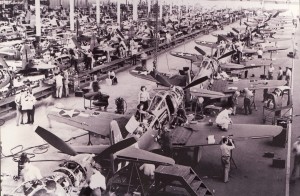
Workers are busy on the P-39 Airacobra assembly line at Bell Aircraft’s Niagara Falls plant. By the time the war ended, Bell had produced 9,584 P-39s. A few examples managed to survive; at last count, three were still flying.
Bell began looking for new business and fresh talent. He hired Robert J. Woods, a gifted design engineer, who had made a name for himself at Lockheed Aircraft. Soon, business was booming at Consolidated, and Bell wanted his name on the front door. He knew he could raise capital in Buffalo, but he wouldn’t be able to compete with Consolidated on his own. Fleet helped Bell make his decision when Fleet moved Consolidated to California. Bell, along with Ray Whitman, Consolidated’s assistant manager, began making plans to open their own company.
Bell Aircraft
Bell Aircraft was officially founded on July 10, 1935. Whitman wanted a more general name, but Bell insisted that since the early days of aviation, the owner’s name out front was the best way to sell airplanes. However, in later years he would change his mind.
“If you ever start your own company, don’t put your name on it; name it Ajax or something,” he told an engineer. “The responsibilities get too heavy. And when your name’s out front, you have to do a lot of things that are a terrible bore.”
Bell rented two small offices and installed a telephone for his secretary, Irene Bernhardt, who had come over from Consolidated. Bob Woods, who had also joined the fledgling company, set up his drafting board and went to work. The company was capitalized at $500,000; $150,000 had to be raised before Sept. 1. By mid-August, Bell had raised the required funds, but the stress and strain took a toll. He would recall later that at no time in his life did he work harder or worry more. He developed an ulcer, and health problems would plague him for the rest of his life.
Renting a portion of the former Consolidated plant, the company’s initial work was a subcontract for Fleet. In January 1936, Bell Aircraft had 167 employees on the payroll and was renting 80,000 square feet of space.
The Airacuda

The P-39 Airacobra incorporated several innovations, including a V-12 Allison engine mounted behind the pilot, an automotive-style door located over the wing and a 30-mm cannon that fires through the propeller hub. Its tricycle undercarriage was a first.
Bell’s first project would set the standard for the company’s future—a combination of radical design and superior craftsmanship. The military was looking for a super-fighter, capable of destroying bombers that might threaten American cities. Woods’ streamlined design used two 1,000-hp Allison engines to power twin pusher-propellers and had room for a crew of five. Bell coined the name XFM-1 Airacuda.
“Like the barracuda, the Airacuda is sleek, shiny and has big sharp teeth,” he said. It was armed with two 37mm cannons mounted in front of the engine nacelles and several .50 caliber machine guns in the fuselage.
With Woods’ drawing in hand, Bell tried to sell the design to General Frank Andrews. Pointing out his airplane’s ultramodern features, Bell soon found himself under attack. Andrews’ staff was obviously unimpressed; one young pilot wanted to know why the proposed design didn’t have rearward-facing armament. Knowing his airplane was already overweight and that any additional guns wouldn’t help its aerodynamic stability, Bell talked up the XFM-1’s performance.
“We have no provisions for guns in the back, because this airplane is fast enough to keep out of trouble,” he explained. “Nobody catches the fastest guy on the block.” The officers weren’t convinced, and after an uncomfortable silence, Bell bluntly said, “Look, guns in the rear makes about as much sense as putting teeth in the ass of a tiger. You put the teeth in the mouth.”
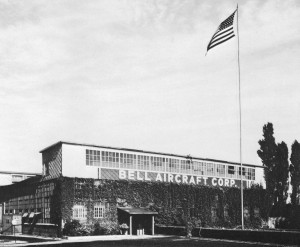
Bell Aircraft Corporation’s first plant was located on Elmwood Avenue in Buffalo. The factory was originally part of Consolidated Aircraft’s facility.
Construction began on the first Airacuda in May 1936. Bell’s company had grown to 642 employees and was using 145,000 square feet of space. The XFM-1 first flew on Sept. 1, 1937, and 13 units were ultimately produced. Although the bomber-killer never saw combat, it proved that Bell Aircraft could build excellent planes.
“It was one of the finest airplanes this country’s ever had, but it was too early,” Bell later said about his first effort. “It was far too advanced for the day.”
In 1938, President Roosevelt sent Bell and 45 other industrial leaders to observe and report on European war preparations. He excitedly wrote Vaughn Bell about the upcoming trip.
“I will learn a tremendous amount about European military aviation and enhance my prestige at home,” he wrote.
Larry and Lucille Bell arrived in Germany for a two-week tour of the country’s aircraft industry. Bell was impressed with German mass-production assembly lines, a far cry from the American workshop concept of building a few airplanes at a time.
“Production methods here are far superior to anything in America or any other country, because they’re doing this on a large scale that lends itself to progressive production methods,” he wrote in a letter home. “You get the feeling they can do anything.”
It was on this trip that Bell would see the Focke Fa-61 helicopter. First flown in 1936, the craft had profound impact on Bell, and he often said that it was the most interesting concept he had seen in Europe.
At one point on the tour, Bell managed to get tangled up in a canvas shroud that was covering an airplane the Germans obviously didn’t want him to see. As the guards hurried to put the cover back on the airplane, Bell casually analyzed the craft.

The P-59 Airacomet, America’s first jet plane, made its inaugural flight on Oct. 1, 1942. Although the fighter never lived up to expectations, experience with the P-59 led to the advanced designs later ordered by the Air Force.
“If anyone else had done it, the Germans would’ve shot him,” remarked Louis A. Johnson, assistant secretary of war.
On his last day in Germany, Bell addressed a luncheon at the air ministry in Berlin.
“You know that I’ll tell my government what I’ve seen,” he said. “That’s the purpose of my visit. But, although I’m traveling to other countries, I won’t give them this information.”
“You can give all the information you want to America,” General Ernest Udet, director of Germany’s technical department, told Bell. “But, we’d rather you not tell England.”
After touring England, Italy and France, Bell returned to the United States and, like Charles Lindbergh, found himself being accused of swallowing the line that the Nazis were becoming a formidable force. He was also charged with wanting to increase military aircraft production for personal gain. In 1939, Germany’s assembly-line products would grab the world’s attention. Bell would go from producing 13 planes a year to 20 a day.
The Airacobra
Back in Buffalo in 1938, Bell Aircraft was planning its next airplane, and once again, Bell came up with a unique way to sell it—producing a 30-minute film, featuring full-scale mock-ups of Bell Models 3 and 4. Eventually, the Model 4 got the go-ahead, and Woods designed the XP-39 Airacobra, first flown on April 6, 1938. The single-seat fighter’s Allison engine was mounted behind the pilot, driving the propeller via a 10-foot shaft. The nose contained several machine guns and a 37 mm cannon, which was fired through the propeller hub.
When William S. Knudsen, head of General Motors and one of Roosevelt’s key authorities on production, came to tour the Buffalo plant, he asked Bell how many airplanes he had manufactured. Bell claimed he had built “hundreds.” The GM chief knew that Bell had worked for Martin and Consolidated, so he asked how many airplanes Bell’s own company had made.
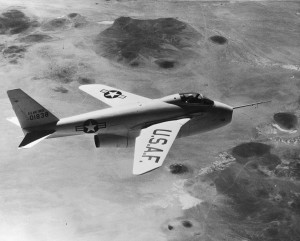
The first aircraft capable of changing the sweep of its wings in flight, the Bell X-5 was based on a German design that never flew. Although only two X-5s were built, the concept would be used successfully in the F-111, F-14 and B-1.
“You’ve trapped me,” Bell grinned. “The truth is, my company has built 15 airplanes since it was started.”
Knudsen was astonished.
“Fifteen airplanes in six years, and you’re calmly talking about producing five a day!” he said. Using his strong selling skills to full advantage, Bell convinced the skeptical Knudsen that Bell Aircraft could get the job done. On Aug. 25, 1941, Bell Aircraft won an order for 2,000 P-39s—a $75 million contract.
Construction had begun on a new plant in 1940. Located adjacent to Niagara Falls Airport, north of Buffalo, the company’s floor space grew to more than a million square feet. In January 1940, Bell had 1,170 employees. At its wartime peak in February 1944, the company employed 50,674. A total of 9,588 P-39s were produced during the war.
As originally conceived, the P-39 could have been one of the best WWII fighters. Instead, numerous additions and modifications added weight without additional horsepower, making the Airacobra incapable of high performance above 10,000 feet. Originally weighing close to 4,000 pounds, a later model would tip the scales at 5,600 pounds.
Less-than-enthusiastic American and British pilots nicknamed it the “Iron Dog,” but the Airacobra would have its greatest success in the hands of Russian pilots, who found the P-39’s heavy firepower effective against ground targets. Bell would also build a more powerful version of the P-39, the P-63 Kingcobra, and an experimental, molded-plywood fighter, the XP-77.
Like many other wartime industrialists, Bell had a bed installed in his office and worked almost around the clock. According to employees, Bell could be found anywhere in the plant. Carl Leuthner (this writer’s father) worked at Bell Aircraft for three and a half decades as an engineer and inspector, and remembers one occasion when Bell walked up to a group of men and asked what they were doing. They explained the project to him, adding that it wasn’t progressing quickly enough, because they had little engineering help. Within half an hour, the place was crawling with engineering talent.

During his career, Larry Bell saw airplanes develop from primitive biplanes to sophisticated machines capable of flying at supersonic speeds.
Although extremely demanding of his executives and department heads, Bell is remembered as a decent and fair boss.
“If somebody left their lunchbox open, Larry wasn’t above reaching in and grabbing half a sandwich,” recalled Leuthner. “Then he’d pull up a stool and make himself at home. He was always interested in what we were all doing.”
Other wartime projects
In addition to the P-39, Bell Aircraft was involved with a myriad of other projects during the war. Bell’s Ordnance Division, located in Burlington, Vt., built gun mounts for the Navy. The Bell Modification Center, at Niagara Falls, was a completely separate factory. Aircraft of all types would be delivered to the plant, and more than 7,000 would go through the center before the end of the war. Bell felt this experience would be extremely useful when the war ended, because the aviation industry would then need to modify military equipment for civilian needs.
Bell also constructed a plant to build B-29 bombers in Marietta, Ga. Many local citizens wanted nothing to do with a “Yankee” aircraft builder, but Bell went to Georgia and sold them on his company. After the war, he saw southern industry continue to grow, and he talked about the impact of the bomber plant.
“I believe, and other people agree with me, that the B-29 plant in Georgia was probably the biggest and most successful single manufacturing enterprise in the country during the war,” he said. “My friends down there have repeatedly told me that Bell Aircraft probably had more influence on the rebirth of the South than anything that’s ever been done.”
The Airacomet
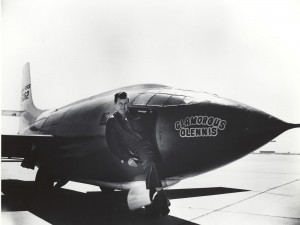
On Oct. 14, 1947, the Bell X-1 became the first airplane to fly faster than the speed of sound. Flown by U.S. Air Force Capt. Charles “Chuck” Yeager, the X-1 reached a speed of Mach 1.06 (700 mph) at an altitude of 43,000 feet.
Bell produced America’s first jet in total secrecy. First flown on Sept. 30, 1942, two General Electric engines supplied the power for the P-59 Airacomet, based on the English Whittle design. An interesting modification was an observer’s seat, built forward of the cockpit. Fifty aircraft were built; although performance never reached expectations, the P-59 was a successful test platform and helped the U.S. begin the jet age.
On at least one occasion, Bell went for a ride in the jet, which must’ve been done with some degree of trepidation. Although he lived and breathed aviation, Bell was never at ease in the air. He realized early on, however, that it wouldn’t look good if the boss didn’t fly in his own planes. In fact, he made it his business to go up in nearly every aircraft he built. However, Bell rarely flew on commercial flights, preferring train travel.
The X-1
Another project begun during the war would become Bell’s single greatest accomplishment. As propeller-driven fighters began to go faster, and the jet became a reality, it was apparent to aircraft designers that a high-speed research craft would be needed to explore and test new speed frontiers. Woods felt that Bell Aircraft should be the company to build the airplane, but his boss knew it would be a hard sell.
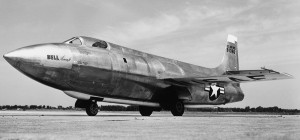
The Bell X-1A was similar to the X-1, except for turbo-driven fuel pumps, a new cockpit design, a longer fuselage and increased fuel capacity. In it, on Dec. 12, 1953, Chuck Yeager reached a record speed of Mach 2.435, at an altitude of 75,000 feet.
“I personally believe in the need for this research,” Bell said. “But when we try to sell the idea, someone’s going to say, ‘What good is this airplane?’ Being ‘just good for research’ isn’t good enough. Not in the middle of a war.”
Woods finally convinced Bell to pursue the idea. A three-view drawing of the proposed craft was made and sent to the National Advisory Committee for Aeronautics in April 1944. The P-59 had already proved that the available jet engines weren’t powerful enough for an airplane of this type. The Navy was also working on a high-speed aircraft and had a rocket engine under development. Since its aircraft would initially be jet-powered, the Navy agreed to let Bell use the rocket engine. Built by Reaction Motors, Inc., this engine would power the X-1 on its historic flight past Mach 1, on Oct. 14, 1947.
In December 1947, President Truman awarded the Collier Trophy—one of aviation’s highest awards—to Bell, John Stack of NACA, and Chuck Yeager, for their roles in the X-1 program. In Bell’s acceptance speech, he paid tribute to his engineers.
“Perhaps the most significant thing about the X-1 is the fact that the airplane has been flown many times in the subsonic, transonic and supersonic ranges of speed in its original configuration, just as it came off the drawing boards”, he said. “Not a single change has ever been made or deemed necessary. That’s a real tribute to the engineers responsible.”
The X-1 would be the first of a record-setting series of Bell-produced research aircraft. Throughout the 1950s, the company built machines that would fly the fastest and highest in the world. Bell’s X-5 was the world’s first swing-wing aircraft. At the end of WWII, Bell sent Bob Woods to Germany. His assignment was to gather as many German engineers and as much German research as he could. Several Germans did join Bell after the war, including Walter Dornberger, former major general and commander of the Peenemünde Rocket Research Institute.
Woods also managed to have a Messerschmitt P-1101 sent to the States. This aircraft, which never flew, had a primitive pivoting wing that could be adjusted only when it was on the ground. It gave the Bell engineers a prototype to follow. When the U.S. Air Force first used the swing-wing concept, it was almost identical to the X-5.
Bell helicopters
It was also during the 1950s that Bell moved the helicopter program to Texas. He felt that having the specialized facility was necessary.
“I want an organization that thinks helicopters morning, noon and night,” he said.
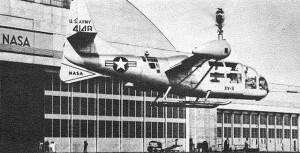
First flown in 1955, the XV-3 was a tilt-rotor aircraft able to hover and transition to forward flight, but had a number of design problems. After an accident during wind tunnel testing during 1965, the program ended.
Helicopters had fascinated Bell since his pre-war trip to Germany. Early in 1942, he met Arthur Young, an engineer who was proving his helicopter designs with models. Bell hired Young and assigned him to an office in a small building south of Buffalo. Young began working on a full-scale helicopter, and on Dec. 24, 1942, the machine was first test-flown on tethers. Work continued during the war, and on March 8, 1946, the Bell Model 47 was the first helicopter to be awarded commercial certification. Bell convinced his board of directors to put the helicopter into production.
“The only way we can sell the helicopter is to have the courage to build some,” he explained.
An assembly line went into action, but sales were slow. The few buyers were farsighted types, who understood the craft’s unique capabilities. But Bell saw the helicopter as a machine for the future.
“People realize that the helicopter is the only vehicle of transportation in the world that’s self-contained,” he said. “If you buy a helicopter, you don’t need to build a road, a harbor, a right of way or an airport. You don’t need anything. You don’t have to follow a road or go to an airport; you just go where you want to go.”
To boost sales, Bell took his show on the road. Armed with films, reports and his own dynamic sales pitch, Bell went to see General Jacob L. Devers, commander of the Army’s ground forces.
“I gave him a dose of helicopters,” Bell said.
Again, Bell found himself in front of a skeptical group of military men. One general suggested, “You ought to make your helicopter ‘roadable.’ Then, it would be really versatile. It could land in a pasture, shift gears, become an automobile, and then drive up the road to headquarters.”
“General, that must be intended as a joke,” Bell responded. “It would be like putting wheels on a seagull. Why land in a pasture and drive to headquarters on a road? You don’t need a road. You fly to headquarters and land at the front door.”
Bell sent one of his test pilots to tour military bases across the country, with instructions to demonstrate the helicopter every chance he got. Not only was he to take the officers for rides, but their wives and children, too.
The Korean War changed everything for the whirlybird. Not long after the conflict broke out, Bell received his first order from the Army—for 500 helicopters. The Model 47 would go on to become a legend, used to save thousands of wounded soldiers evacuated to mobile army surgical hospitals (MASH units). Bell helicopters saved lives again in Vietnam, but also came to be known as formidable attack craft.
When WWII ended, Bell, like other manufacturers involved with the war effort, found himself with huge plants, large numbers of employees and no contracts. A variety of projects were undertaken to keep the doors open. One of these was the “Tarzan Bomb.” Among the first “smart bombs,” it was built at the Niagara Falls plant. Radio controlled, the bomb carried a 6,700-pound warhead and could be directed to the target with surprising accuracy.
In Vermont, the Ordnance Division, now renamed the Burlington Division, began an assembly line to build small power plants for use on garden equipment. When Bell saw his company’s success with these engines, he created a motorized wheelbarrow. Called the “Prime Mover,” and patented in Larry Bell’ name, it was described as a “rugged and versatile machine that carries a half-ton load of raw or finished goods almost anywhere a man can walk, uphill or down, indoors or out, over rough or smooth ground.”
The company was also involved with an airplane called the “Bald Eagle.” The X-16 was designed to be a twin-jet spy plane, capable of photographic missions at great altitude, but was never built. Many aviation experts assume the project was canceled when Lockheed built and flew the U-2, an airplane that performed the same task.
Bell flew the first jet-powered vertical takeoff and landing aircraft on Nov. 16, 1954. This was in addition to the company’s work on the XV-3 convertible, an aircraft with three-bladed, tilting propellers at the end of each wing, allowing the plane to fly forward and to hover, combining the takeoff and landing capability of a helicopter with the greater range and speed of fixed-wing aircraft.
Bell would also produce—among other projects—numerous guided missiles; the human Jet Belt; the U.S. Navy’s automatic carrier landing system, which allows an aircraft to be landed without the pilot’s assistance; engines and equipment for the space program; and air-cushion vehicles.
During the late 1940s and early 1950s, Bell weathered both a hostile takeover attempt of his company and a bitter strike. With employment down and future prospects shaky, Bell’s employees walked out on June 13, 1949, and didn’t return to work until October. Several incidents of violence took place, as strikers tried to prevent other employees from entering the plant. At one point, troops were put on alert, in case the situation intensified.
Bell drove past the large tent the strikers had erected outside the plant’s main gate. After watching the men and women circling outside the gate, holding signs, he said, “That’s the first time I haven’t wanted to look into those faces.”
Remembering a man who did big things
Lucille and Larry Bell separated in 1948 and were later divorced. They had no children. Bell’s health continued to deteriorate, and while he was on a tour of Korea to observe his helicopters in action, he was examined and found to be suffering from heart disease. He resigned as Bell Aircraft’s general manager on Oct. 2, 1954, but continued to work as hard as ever. One of his favorite projects was the Bell Foundation, which provided funds for a wide range of scholarships and causes, which included building a new library in his hometown in Indiana.
On May 20, 1956, Bell suffered a severe stroke, and in September, resigned as president of Bell Aircraft, but was elected chairman of the board. In less than a month, he was back in the hospital, where he died on Oct. 20. A few close friends were with him at the end.
The funeral was held at Buffalo’s Delaware Avenue Baptist Church, and Bell’s words were printed in the church bulletin.
“Show me a man who cannot bother to do the little things, and I’ll show you a man who cannot be trusted to do big things,” it read.
Textron, Inc. bought the defense business of Bell Aircraft in 1960. Today, Textron’s Bell segment is comprised of three businesses that are global leaders in the aviation and defense industries. One-third of the world’s operating helicopters carry the Bell Helicopter Textron name. Textron Defense Systems, a wholly-owned subsidiary of Avco Corporation, provides innovative, advanced technology solutions for combat, surveillance and security missions. Lycoming Engines, a division of Avco, is the world leader in the design and manufacture of reciprocating piston aircraft engines for the global aviation industry. In 2005, these businesses contributed 29 percent of Textron’s total revenues, with approximately 13,000 employees.
Those who knew Bell and respected his work will not forget him. In Donald J. Norton’s “Larry: A Biography of Lawrence D. Bell” (Nelson-Hall, 1981),” Jimmy Doolittle wrote about Bell in the foreword.
“When Larry first became interested in aviation, airplanes had a top speed of around 40 miles per hour and a ceiling of about 4,000 feet,” Doolittle wrote. “At the time of his death in 1956, his supersonic X-2 had just been flown at a speed of 2,148 miles per hour and to an altitude of 126,200 feet. The technology was at hand to put man into earth orbit and, with further development, on the moon.”












